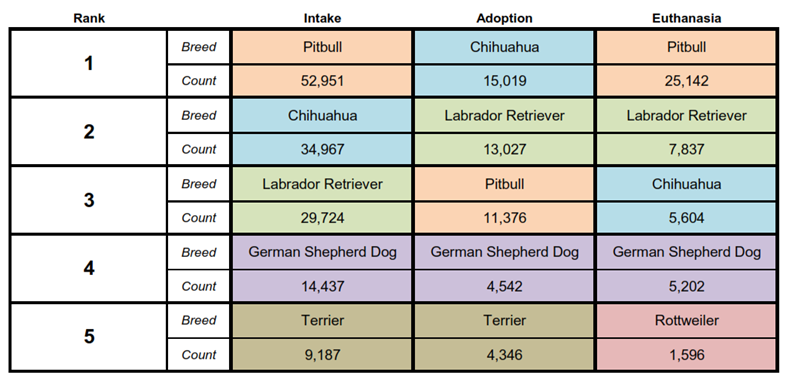Dr. Emily Weiss shares evidence pointing to the fact that pit bull-type dogs are increasing in popularity.
 Who is most at risk at your shelter?
Who is most at risk at your shelter?
One of the most common responses I receive when I ask this question is “pit bull-type dogs.” When I ask why they are at risk, the most common response I receive is that people are not coming in to adopt pit bulls.
Not sure if you read my blog post from last year that noted that pit bull-type dogs are increasing in popularity, but we now have more evidence pointing to the fact that pit bull-type dogs are very popular and wanted, with Banfield’s recent release of its “State of Pet Health™ 2014 Report.” The report is pretty rich, as it represents data on 2.3 million dogs and 470,000 cats coming to the 850 Banfield hospitals around the country. Once again, pit bull-type dogs rated as number 5 in the top ten dog breeds cared for in Banfield hospitals. This trend made me want to learn more…
The ASPCA has a new individual animal database called CARDS (Comprehensive Animal Risk Database) that allows us to dig into data in new and really exciting ways – including an ability to break out breed and outcomes. We pulled the data from over 30 shelters from around the country that had relatively clean breed data in the system and what we found was quite telling.
We asked what are the top breeds (including mixes with primary breed listed) available to be adopted at their agencies, and this is what we found:

Pit-type dogs are the third most frequently adopted. Wow. That is a lot of dogs.
We then pulled the data on intake and outcomes and here is where the story gets juicy…

Guys – maybe we do not have an adoption problem – but instead we have a volume issue! One-third more pit bulls enter than the next highest intake breed type. Certainly a subset of those labeled "pit type" do not have a DNA profile indicating any bully breed, but it is also likely that some pit types are labeled as another primary breed. Why are they coming in at such a higher volume? Given the level of popularity (#5 most popular with Banfield clients), we would anticipate that they would not be the #1 intake type.
Based on our research on the relinquishment of large dogs, I hypothesize that part of the answer has to do with the difficulty in finding housing that allows pit-type dogs. People with a pit-type dog who need to find housing likely have more difficulty than those looking for housing with their beagle mix. It is then a double whammy – as we know that many dogs are re-homed without ever entering the shelter, but if person A has trouble finding housing that will allow them to keep their pit-type dog, that same person will likely have difficulty finding someone else who can take the dog home.
This we can fix.
What are your thoughts as to the other drivers for the high volume of pit-type dogs into the sheltering system? What are your thoughts for solutions?
No comments:
Post a Comment